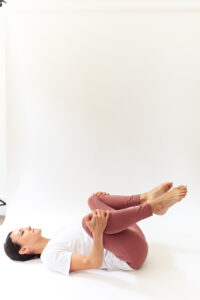If you’re thinking, “What the heck is vaginismus?” you’re definitely not alone. Many people with vaginas have never heard of it, and here’s why: Vaginismus symptoms can feel embarrassing to talk about.
“I can’t insert a tampon.”
“No matter how hard I try, I can’t ‘just relax’ during a pelvic exam.”
“It’s like I clamp shut when I try to have sex.”
If you’ve experienced any of these symptoms, I want you to know you’re not alone, and you don’t have to suffer in silence. Let’s talk about exercises you can be doing to help with your vaginismus symptoms.
What is Vaginismus?
Vaginismus is the body’s automatic, involuntary response to the fear of some or all types of vaginal penetration. It causes tensing or contracting of the muscles in and around the vagina and makes penetration painful—or even impossible.
This leads to symptoms like:
- Discomfort or pain during any penetration (fingers, genitals, tampons, medical instruments, and so on)
- Inability to have sex or a pelvic exam
- Burning or stinging pain at the vaginal opening
- Increased fear of pain or sex
- Decreased sexual desire
And whether it’s caused by fear of penetration or another medical condition, one thing is for sure: Vaginismus is both physically painful and emotionally challenging.
Tension in your pelvic floor muscles plays a role in the discomfort and pain associated with vaginismus and can wreak havoc on your health and happiness.
The good news is pelvic floor tension is totally treatable!
Kegel Exercises for Vaginismus?
When we think about pelvic floor health, most people immediately jump to kegel exercises. But, for folks with vaginismus, this isn’t the best idea.
Kegel exercises aim to strengthen your pelvic floor muscles by intentionally contracting and relaxing them. But because vaginismus is caused by tension in those muscles, strengthening them even more, on purpose, may bring more problems.
So what needs to happen first?
Relaxation.
That means avoid those cookie-cutter kegels until your pelvic floor is more relaxed. Try these pelvic floor exercises and stretches for vaginismus instead!
Pelvic Floor Exercises for Vaginismus
#1 Diaphragmatic Breathing
Deep belly breathing is an important step for any muscle relaxation. And it does wonders for your pelvic floor!
Lie on your back with your knees bent. Put one hand on each side of your rib cage. Deeply inhale, inflating your ribcage as if it’s opening up like an umbrella then slowly exhale. Allow one breath to flow smoothly to the next and repeat for 10-20 breaths.
#2 Child’s Pose
Kneel on the floor. Touch your big toes and spread your knees wider than your hips. Rock your hips backward onto your heels and stretch your arms forward. Exhale and move your torso closer to the ground. Hold the pose for 5-10 breaths.
#3 Cobra Pose
Lie stomach down on the floor. Place the palm of your hand next to your shoulder and hug your elbows into your body. Press the tops of your feet, thighs, and pubic bone firmly into the floor as you inhale and straighten your arms, lifting your chest off the floor. Squeeze your shoulder blades together as you lift your chest up toward the sky. Hold the pose for 5-10 breaths. Breathe easy, exhaling as you release back to the floor.
#4 Happy Baby Pose
Lie on your back. Exhale and bring your knees to your belly. Inhale and grip the outside of your feet with your hands, opening your knees slightly wider than your torso. Bring your knees toward your armpits. To create resistance, push your feet up into your hands as you gently pull downward. Hold the pose for 5-10 breaths.
#5 Deep Squat Stretch
Stand with your feet slightly wider than hip-distance with your toes pointed slightly outward. Slowly bend your knees and push your bottom back, as if you’re about to sit down. As you squat, put your elbows on the inside of your thighs, press your palms together and imagine pulling your belly button toward your spine. Your heels can be lifted or you can place a rolled towel or yoga mat under your heels for more support. Hold the pose for five slow breaths and then slowly rise. If deep squats are new to you, try stacking a couple of yoga blocks on the floor to support your bottom during the squat. As you gain strength, you can remove one block and then both blocks.
#6 Vaginal Dilators and Wands
Vaginal dilators/trainers look like a set of tampons of increasingly larger diameter. Inserting these into the vaginal canal can help desensitize your vaginal tissues, relax your muscles, and soften any scar tissue at the vaginal opening.
A pelvic floor wand is also an excellent vaginal accessory. It looks like a small dilator with a curved tip at the end. It can be used to apply pressure to tender, tense muscles to help them relax. Basically, a Swedish massage for your lady bits. Intimate Rose has my favorite products!
Pelvic Floor Physical Therapy for Vaginismus
Vaginismus can be a complex condition. While at-home exercises and stretches are great, you might find you need more support.
Enter pelvic floor PT.
A pelvic floor physical therapist can help you:
- Diagnose pelvic floor dysfunction.
- Learn exercises to strengthen your pelvic floor muscles.
- Practice stretches that relax those all-important areas.
- Resolve symptoms like incontinence, constipation, pelvic pain, prolapse, and more.
- Provide more tailored recommendations for pelvic floor exercises for vaginismus
It’s time to relax.
In The V-Hive Relaxation Series, you’ll find more stretches and products that can help ease pelvic floor tension from the comfort of your own home. Start your 7-day trial and start finding relief today!










